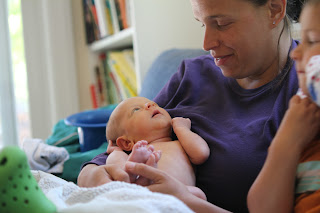I often read a book and find the information useful but contradictory to other things I have read or other of my established viewpoints. This was not the case with Real Foods for Mother and Baby. Nina Planck has written a book which covers the essentials of foods for pregnancy, nursing, and introducing foods. She has also expanded on food a bit, and touches on exercise and parenting.
She starts by describing what real food is. Then she discusses traditional and modern fertility foods, then goes on to pregnancy foods, then nursing foods, then foods for baby. She tries to simplify, and her main message is to eat real food, and make sure and eat meat as well. She touches on some "hot" topics like drinking while pregnant, and raw milk, and exercise. She has done her research, and cites her arguments thoroughly.
Interestingly enough, her research base is very similar research to mine and she has come to similar conclusions. She cites Clapp (the researcher who says to exercise throughout pregnancy, and hard), Dunstan (the researcher who says your preverbal baby has something specific to say and shows you how to hear it), Price (the dentist who researched traditional foods and concludes to avoid white sugar and white flour, and to add cod liver oil and raw butter from cows fed on spring growing grass), Pollan (the writer who coined the term "nutritionism") and others.
She also says that a pregnant woman is told so many things, and gets worried, which I agree with. There is too much information out there, and too many choices. She says that if it is real, eat it. If not, skip it. She goes into a bit more detail in the pregnancy section, attempting to steer pregnant ladies towards nutrient-rich foods in the first trimester, calcium-rich foods in the second trimester, and omega-3 (fish) rich foods in the third trimester to parallel the baby's development.
I agree with most of her points on foods and the like, but disagree that you can't keep your children from eating sugar beyond a year. I think kids will eat when they are hungry and will eat what they are used to seeing, be it sugar or chopped liver.
Overall, I found this book easy to read but also well researched and cited. She cites her own experience a bit more than needed in the book, though. If her sample size was larger than one small child, it would have been more useful to hear about her experiences. The book was informative but modest. It would be a good addition to any prenatal library. I will gladly recommend this to pregnant friends.













































